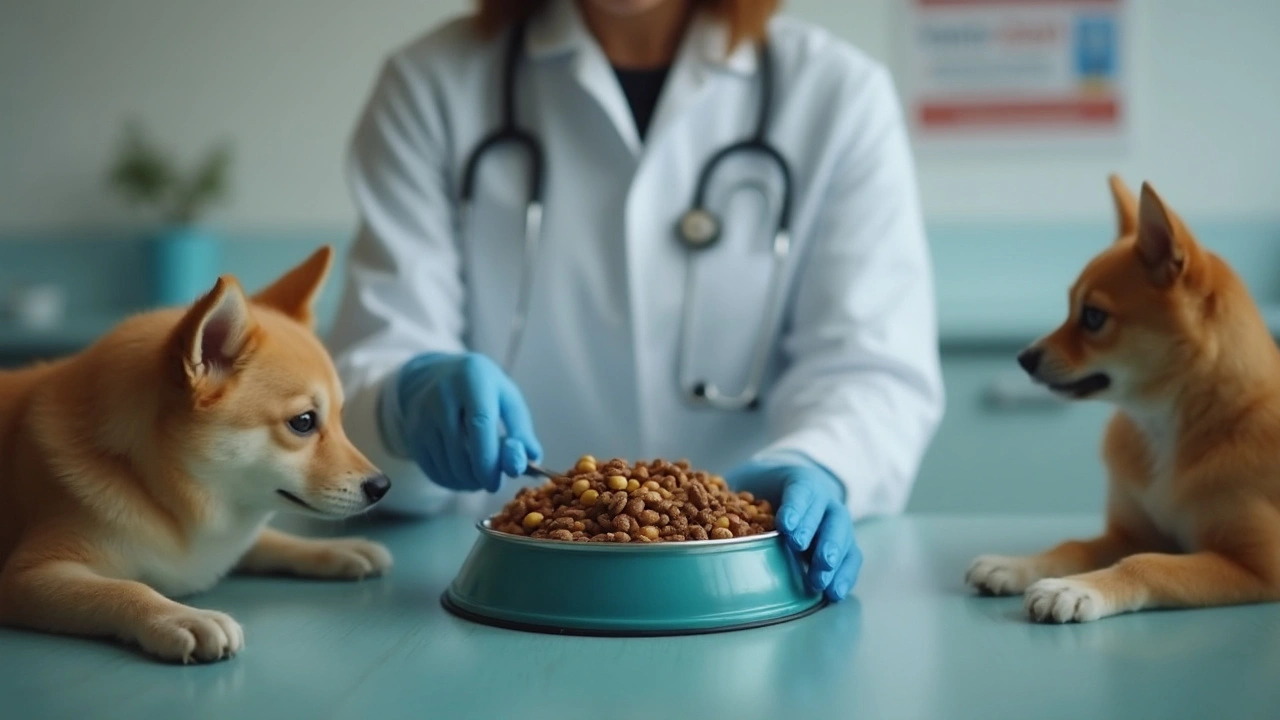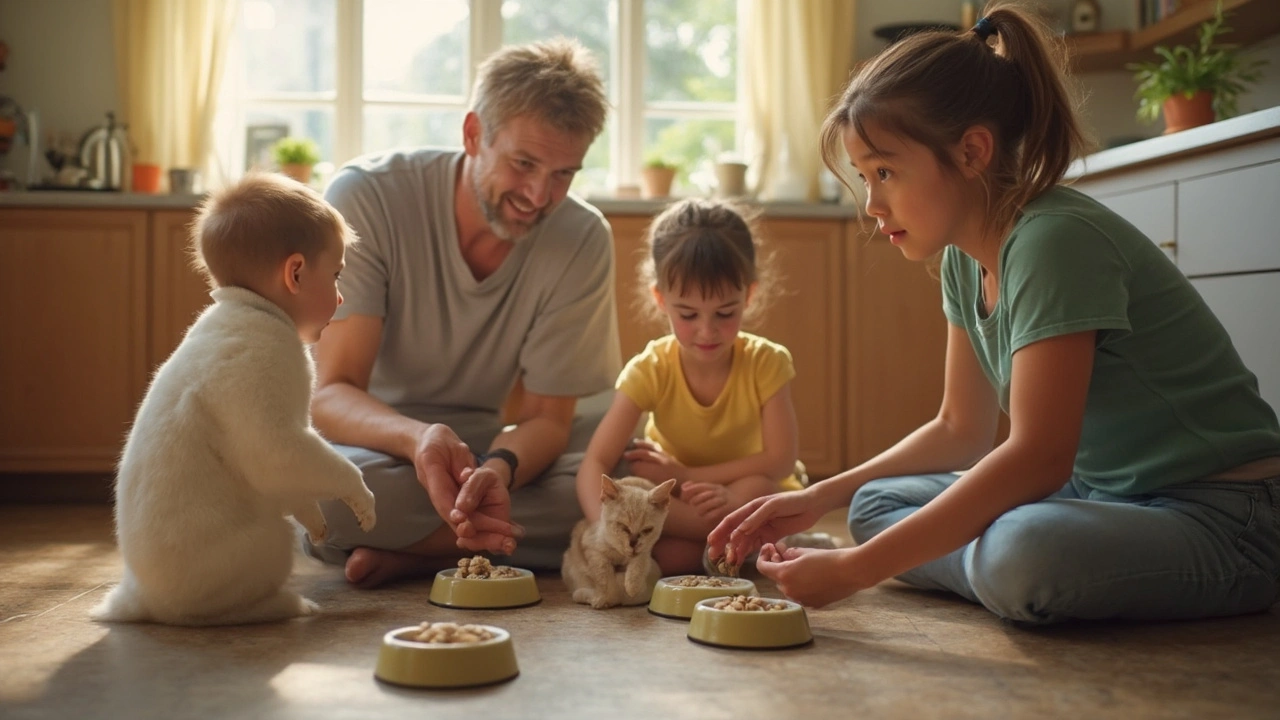You bring home a bag of treats for your dog, but you probably never expect a foodborne bug to be hiding inside. Salmonellosis isn’t just a human problem—pets catch it too, and those raw food diets and backyard scavenger hunts make it even more common than most folks know. The bacteria, Salmonella, can lurk in undercooked meat, contaminated pet food, or even on chew toys that haven’t been washed properly.
What’s really tricky is pets don’t always show clear signs they’re sick. Sometimes you just see vomiting or diarrhea, or, honestly, nothing at all. Even worse, infected pets can spread the germ to other animals—and to you—without ever acting sick themselves. That’s why it pays to know how salmonellosis creeps into homes, which foods and habits raise the risk, and the small changes that add serious protection for your cats and dogs.
- What Is Salmonellosis and How Do Pets Catch It?
- Warning Signs: When to Worry about Your Pet
- Keeping Your Home and Pets Safe
- What to Do If Your Pet Gets Sick
What Is Salmonellosis and How Do Pets Catch It?
Salmonellosis means a pet—usually a dog or cat—got infected by Salmonella bacteria. You hear about food recalls for salmonellosis in people, but animals run into trouble too. The biggest issue? Salmonella isn’t picky about its host or where it hides. It can survive in undercooked meat, dry dog food, raw treats, and on surfaces that touched contaminated stuff. A study out of Cornell University found that roughly 20% of commercial raw pet foods tested positive for Salmonella, compared to less than 1% for regular dry kibble. That’s a big difference.
Pets pick up salmonellosis by:
- Eating raw or undercooked animal products—think raw chicken, eggs, or certain bones.
- Licking or chewing on dirty food bowls, toys, or surfaces where Salmonella has landed.
- Getting into garbage, hunting rodents, or snacking on wild birds (dogs are notorious for that one).
- Living in multi-pet homes, shelters, or places where sick animals have been.
You don’t always see your pet get into something gross, but that’s usually the route: their mouth, their paws, then everywhere they go.
"Salmonella can live for weeks in dry environments and even longer in moist foods or on surfaces. Pets can shed the bacteria without acting sick at all," says Dr. Lisa Weeth, board-certified veterinary nutritionist.
Not every dog or cat that snags Salmonella gets sick right away. Young pets, older animals, or those with health problems have a tougher time fighting it off. Even healthy animals can keep shedding the bacteria in their poop for several weeks. Along the way, they could spread it to other pets, or drag it onto the couch, kitchen floor, or anywhere else you hang out together.
| How Salmonella Spreads | Common Sources |
|---|---|
| Eating contaminated food | Raw meat, some treats, eggs |
| Drinking contaminated water | Puddles, bowls left outside |
| Contact with other infected pets | Multi-pet homes, pet shelters |
| Contact with wildlife droppings | Birds, rodents |
Once you know these routes, it’s easier to spot where the risks pop up in daily life with your pets. These facts aren’t here to scare you—just to show where to be a little extra careful so your best animal buddy stays healthy.
Warning Signs: When to Worry about Your Pet
When it comes to salmonellosis in pets, the signs can be sneaky or pop up all of a sudden. The classic symptoms in dogs and cats are usually stomach issues, but there’s some other stuff to keep on your radar too. Even if you’re used to your pet acting a little weird sometimes, certain changes should put you on alert.
- Diarrhea: The most common symptom, often smelly and maybe even streaked with blood or mucus.
- Vomiting: Not just a one-off hairball or after eating grass—a few rounds of throwing up in a day is a problem.
- Lack of energy: If your playful pup or curious cat just wants to lie around, there might be a reason.
- Loss of appetite: Skipping meals or barely touching treats is a big red flag, especially if it lasts more than a day.
- Fever: Harder to spot, but you might notice your pet feels warm or is panting more than usual.
- Dehydration: Sunken eyes, dry gums, or less peeing—these aren’t just signs of getting old; they may mean your pet’s getting sick fast.
Cats, in particular, have a habit of hiding when they’re sick. You might not see the mess, but if you notice your cat hasn’t used the litter box, or you see watery poop, don’t assume it’ll pass.
If you’ve got more than one pet or kids in the house, you really want to catch these warning signs early. Salmonella passes pretty easily, and spaces where pets share bowls, toys, or beds mean germs can move fast.
| Symptom | Percentage of Cases |
|---|---|
| Diarrhea | 85% |
| Vomiting | 60% |
| Lethargy | 45% |
| Loss of Appetite | 40% |
If your pet health worries match anything on this list and it lasts longer than 24 hours, or if the symptoms get worse quickly, it’s time to call the vet. Waiting it out can mean the difference between a quick recovery and a really rough time—for both your pets and your family.

Keeping Your Home and Pets Safe
Stopping salmonellosis at home isn’t rocket science, but a few smart habits make a real difference. Wash your hands after handling pet food, bowls, or poop—sounds basic, but most people forget after cleaning litter boxes or picking up in the yard. That one lazy moment is all it takes for salmonella to spread.
If you have kids, teach them the same rule. Young children actually get sick from pets more often because they put their hands in their mouths without thinking twice. Same goes for folks with weaker immune systems like older adults and anyone going through tough medical treatments—don’t skimp on hygiene.
- Stick to reputable brands of pet food and treats and store the bags away from your own food.
- Skip the raw feeding craze unless you’re fully prepared to handle raw meat safely, just like you’d do prepping food for people.
- Wash pet food bowls and water dishes with hot, soapy water every day. Don’t just rinse; scrub.
- Avoid letting pets drink from the toilet, gutters, or puddles—those are hot spots for germs.
- Disinfect toys and bedding regularly, especially if your pet spends time outdoors.
Here’s a quick look at just how easily pets can pick up bacteria from their environment:
| Source | Chance of Salmonella |
|---|---|
| Raw chicken diets | Over 30% |
| Outdoor cat hunting rodents | Medium to high |
| Canned or dry commercial food | Low |
| Dirty water/ponds | Variable, often high |
Visitors bring their own risks, too. If you’re having friends or family over, ask them not to feed scraps to your pets—some leftovers can carry bacteria or upset a pet’s stomach. And if you bring home a new furball—especially from a shelter or breeder—have them checked by your vet before mixing them with your other pets.
What to Do If Your Pet Gets Sick
If you even suspect your pet has salmonellosis, don’t just wait it out—catching the problem early makes a world of difference. The first signs might be diarrhea, vomiting, a sudden loss of appetite, or just acting weird and tired. Some pets recover on their own, but for puppies, kittens, or any animal already struggling with health, salmonella can be a real threat.
Call your vet right away if you notice anything off, especially if the poop is bloody, your pet’s drooling a lot, or seems really down. Your vet might ask for a stool sample, so save one if you can. Treatment usually means supportive care: keeping your pet hydrated, rested, and maybe on a bland diet. Sometimes, antibiotics get used, but your vet will decide because treating salmonella isn’t always straightforward.
"Salmonella infection in pets isn’t rare, and sick pets can easily pass the bacteria to people, especially young kids," says Dr. Megan Shepherd, DVM, board-certified veterinary nutritionist. "The best move? Visit your vet at the first sign of illness and be careful with hygiene until you know what’s going on."
Here’s what to do if you think your pet might have salmonellosis:
- Keep your pet away from other animals and family members as much as possible.
- Disinfect food and water bowls, bedding, and any surfaces your pet’s touched with a pet-safe cleaner.
- Wash your hands well after handling your pet, their food, or anything they've come in contact with.
- Stick to your vet’s advice for care, especially with food and water. Offer small amounts of plain food (like boiled chicken and rice) and lots of fresh water.
- Watch out for any new symptoms or if things get worse—let your vet know right away if you see anything alarming.
Here’s a quick look at common signs and what actions help most:
| Symptom | What To Do |
|---|---|
| Watery or bloody diarrhea | Call vet, keep pet hydrated, collect stool sample |
| Vomiting | Withhold food briefly, offer water, call vet if it persists |
| Lethargy or low energy | Quiet rest, limit interactions |
| No appetite | Try bland food, alert vet if more than 24 hours |
Cleaning and staying alert are just as important as medical treatment. Stay patient—it usually takes a week or two for a healthy adult pet to bounce back, but never risk guessing with pet health. Get a pro involved and keep everyone in the house safe while your furry friend recovers.






Iván Cañas
April 28, 2025 AT 11:46Great post, this is exactly what I needed to read after my dog got sick last month. I switched to cooked food immediately after the vet diagnosed salmonella from a raw treat, and it's been a game-changer. I also started checking the FDA pet food recall list weekly-so many brands get flagged without anyone realizing it. Washing bowls daily with hot water has become non-negotiable for me now. My vet even suggested freezing raw treats for a few days to kill bacteria, which I'm doing for any new purchases. It's wild how many ways pets can pick up germs without us even noticing. The Cornell study stats really hit home for me. I've shared this with my pet group too-so many owners are clueless about raw food risks. Honestly, this should be required reading for everyone with pets. Thanks for putting this together, it's so thorough and helpful.
Jen Basay
May 5, 2025 AT 23:46My cat had salmonella from a raw treat last year and I was so scared! 😿 I didn't know it was possible until the vet called me. Now I only use dry kibble and wash her bowls after every meal. I even set up a little indoor play area so she doesn't go outside hunting birds anymore. The vet said outdoor cats get it way more often, which made me realize how careless I was being. I've been checking the FDA recalls every week and it's crazy how many products get pulled. My dog's food had a recall last month and I'd have never known if I didn't check. This post is so spot-on-it saved me from another scare. I'm so glad I found it before it got worse with my pets.
Hannah M
May 13, 2025 AT 11:46Jen, I'm so sorry your cat got sick 😢 That's exactly why I was terrified when my kitten had diarrhea last year! I thought it was just a stomach bug, but the vet found salmonella from a contaminated toy. 🐾 I started washing all her toys with vinegar and hot water, and now I only buy toys from stores with good reviews. It's so easy to overlook how things like toys can get dirty, but I've made it a habit to check them daily. Also, I've been avoiding letting her hunt birds since then-she's a backyard cat, but I keep her indoors more to prevent contact with rodents. The vet said it's super common in outdoor cats, so I'm extra careful now. I'm so glad you're doing better, and thanks for sharing your story-it helps me feel less alone in this! 🐱❤️
Poorni Joth
May 20, 2025 AT 23:46Hannah, you're being so naive and irresponsible! This is exactly why raw food diets are dangerous for pets, and you should stop feeding it to your cat immediately. The article clearly states that raw food has a 30% chance of containing salmonella, but you're still using it despite the risks. Also, your grammar is terrible-'Pip' is a name, not a cat, and you have a lot of typos in your comment. You should learn how to write properly before giving pet care advice. It's not just about the food; it's about your lack of knowledge and care for your pet's health. I've seen so many pets get sick because owners like you don't do their research. You're putting your pet at risk by not using safe food sources and not washing toys properly. The vet would be furious if they saw your comment-your advice is dangerous and misleading. You should be ashamed for spreading misinformation.
Yareli Gonzalez
May 28, 2025 AT 11:46This post is so important! I run a pet care blog and I've seen so many people overlook salmonella risks, especially with raw diets. My top tip is to always wash your hands after handling pet food, and I've made a checklist for my clients to follow. It includes things like washing bowls daily, checking for recalls, and avoiding raw treats. I've also started a community group where we share safe food brands and vet tips. It's a small habit that makes a huge difference in preventing illness. I'm glad you shared this-it's exactly what the community needs to hear. Many pet owners don't realize how easy it is for bacteria to spread, especially in multi-pet homes. I've had clients who didn't know their dogs were shedding salmonella without symptoms, and it took a while to figure out. So, I always stress the importance of early detection and hygiene. If you're new to pet ownership, this post is a great starting point. I've included a link to the CDC's pet food safety page in my next blog post. Thanks for the great content!
Alisa Hayes
June 4, 2025 AT 23:46Just a quick note on the grammar and phrasing in this post-it's great overall, but I noticed a few things that could be polished. The word 'Salmonella' is correctly capitalized in most places, but in the table under 'How Salmonella Spreads', it's written as 'Salmonella' consistently, which is good. However, in the section about raw diets, it says 'over 30% of raw chicken diets'-should it be 'raw chicken-based diets' for clarity? Also, the phrase 'hot spots for germs' is a bit colloquial; 'high-risk areas' would sound more professional. Another point: the title says 'Sneaky Bacteria', but 'sneaky' is a bit informal for a health topic-maybe 'Unseen Threat' or 'Silent Invader' would be better. I'm not trying to nitpick, but these small tweaks would make the post even more effective for a wider audience. The content is spot-on, though-really helpful info on prevention. I've been using this post as a reference for my clients and it's been a lifesaver. Thanks for writing such a thorough piece!
Mariana L Figueroa
June 12, 2025 AT 11:46Wash pet bowls daily. Done.
mausumi priyadarshini
June 19, 2025 AT 23:46Actually, salmonellosis in pets is extremely rare and the article is exaggerating the risk! The CDC says less than 1% of pets get it, so your fear-mongering is unnecessary. I've been feeding my dog raw food for three years with no issues, and I handle it exactly like I would human meat-washing hands, using separate tools, and storing it properly. Your post is misleading people into thinking it's a huge problem when it's not. The study you cited from Cornell University only tested raw pet food, not all raw diets, so it's not a fair comparison. The table on 'Chance of Salmonella' is also inaccurate because it doesn't account for proper handling. Raw diets are a healthy choice for many pets, and your article is doing a disservice by spreading misinformation. I'm disappointed in the lack of balanced reporting here. You should stick to facts, not scare tactics. The truth is, salmonellosis is rare, and most pets handle it fine if they're healthy. Your post is causing unnecessary panic.
Carl Mitchel
June 27, 2025 AT 11:46This is basic pet care 101, but I'll explain it for you since it seems like many people don't know the basics. Salmonella is a bacteria that lives in raw food, so stop feeding raw diets immediately-it's a major risk factor. Always wash your hands after handling pet food, and use a pet-safe disinfectant on bowls and toys to kill bacteria. If your pet has symptoms like diarrhea or vomiting, take them to the vet immediately; don't wait for it to get worse. The CDC has clear guidelines on pet food safety, so you should read those instead of spreading panic with misleading articles. I've been a vet tech for 10 years, so I've seen countless cases where raw diets caused serious illness. The Cornell study you mentioned is accurate, but it's not the whole picture-most pets are fine with proper handling. However, the average pet owner doesn't know how to handle raw meat safely, so it's better to stick with cooked food. Also, the table on 'How Salmonella Spreads' is correct, but it's important to note that not all raw foods are contaminated-just a percentage. But why take the risk? It's easy to switch to safe food, and it's worth it for your pet's health. I've seen pets die from salmonellosis because owners ignored these basic precautions.
Suzette Muller
July 4, 2025 AT 23:46I had a similar scare with my cat last year-she got salmonella from a raw treat, and it was terrifying. She was vomiting and lethargic for days, and the vet confirmed it was salmonella from the treat. Turns out, she'd been hunting birds in the backyard, which is a common source of bacteria. The vet said it's common in cats that hunt birds, so I keep her indoors now and don't let her outside unsupervised. I also wash her food bowl daily with hot water and use a pet-safe cleaner to disinfect it. It's amazing how small changes make a big difference-like checking food recalls and avoiding raw treats. I've also started using a separate bowl for her food and water to prevent cross-contamination. The vet recommended a bland diet for a few days, which helped her recover quickly. I'm so glad this post is out there to help others avoid what I went through. Many people don't realize how easy it is for pets to get sick from everyday activities. I've even recommended this post to my friends with pets, and they're all making changes too. The key is consistency-doing these things every day makes them automatic.
Josh SEBRING
July 12, 2025 AT 11:46This is all nonsense. My dog ate raw meat for years and never got sick. You're making a big deal out of nothing and scaring people unnecessarily. The CDC doesn't say raw food is inherently risky-it's the handling that matters, and I handle it just like I would human food. I wash my hands, use separate cutting boards, and store it properly, so there's no risk. You're spreading fear without evidence, and it's ridiculous. I've seen this same post on other forums, and it's always the same overblown claims. My vet even told me raw food is better for pets, so your article is factually wrong. The '20% of raw pet food' statistic is from a study that tested contaminated samples, not all raw food. You should do your research before writing posts like this. Also, the part about 'backyard scavenger hunts' is ridiculous-dogs are supposed to hunt! You're making it sound like it's a bad thing. I'm tired of people like you causing panic over nothing.